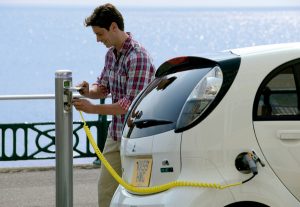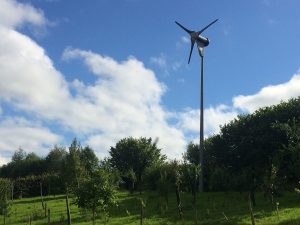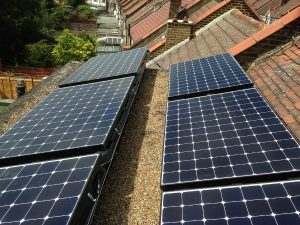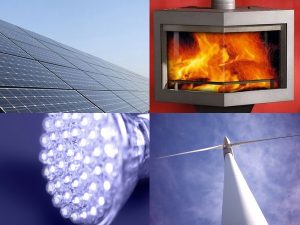Green electricity - introduction
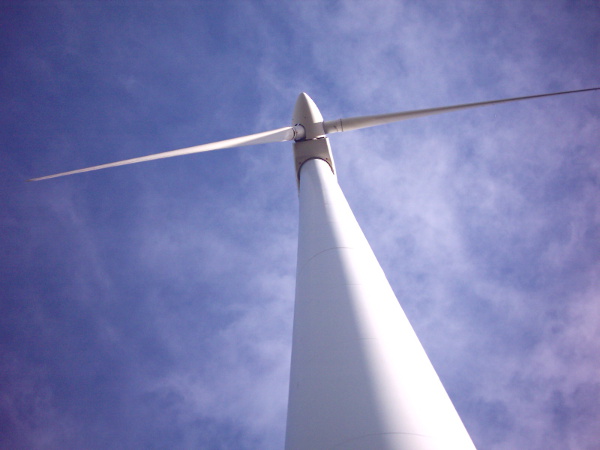
“We are like tenant farmers chopping down the fence around our house for fuel when we should be using nature’s inexhaustible sources of energy – sun, wind and tide.” – Thomas Edison
Contents
What is green electricity?
This topic is about choosing suppliers that get their electricity from renewables. There are ways to produce your own green electricity, for example using solar PV, wind, hydro, or micro-CHP (although this last one uses fossil fuels, with electricity generated as a by-product of heating) – together with a battery system if you want to be ‘off-grid’. But the vast majority of people in the UK are ‘on-grid’ – i.e. connected to the National Grid – and most of the electricity put into the National Grid is ‘brown’, from power stations using fossil fuels (coal, gas, oil) or nuclear.
But now some companies are feeding the National Grid using renewables – for example large wind turbines or hydro-electricity. This is ‘green’ electricity. Also included in the ‘green’ category is electricity from companies that use your money to research and build new renewable generation capacity, or to invest in projects to absorb or reduce carbon emissions in some other way.

Hillsides are obviously good locations for wind turbines; but there is no reason that they can’t be placed in other locations where they will have very little visual impact, such as industrial estates, agricultural or urban area, or alongside motorways.
Two more things that you need to know: Firstly, there are two types of company involved in providing green electricity – suppliers and generators. Some companies have no electricity generating capacity, but supply the public with electricity that they have purchased from generating companies. Other companies (e.g. Good Energy and Ecotricity) are both suppliers and generators.
Secondly, if you switch to a green electricity supplier, you won’t then be able to trace your electricity back to a wind turbine. It simply means that the more people switch, the greater the proportion of green electricity in the National Grid.
One type of green electricity we particularly favour is community energy, where communities come together to set up co-operatives to generate electricity or heat from renewables. Ownership of our energy supply is very important. We don’t think it should be concentrated in just a few corporations – we don’t think that’s good for energy security or democracy. Plus the corporate system is based on perpetual growth, which will continue to damage nature whatever the source of our energy. This is not often addressed by energy experts who understand terawatts but not necessarily political philosophy.

Large wind turbines – love ’em or loathe ’em, but really, this is what we should be campaigning against.
What are the benefits of green electricity?
This is not about home-scale micro-generation from renewables. This is about your contribution to large-scale renewable energy developments, like wind farms, large hydro-electric power schemes, and also wave and tidal power. There is some opposition to large renewable energy projects, notably wind farms, and we respect people’s opinions about the effects of wind turbines on the landscape. We wouldn’t want turbines on every hillside, but we think that ultimately, ecology (which after all, supports human life on this planet) is more important than the view. And anything that mitigates the problems below has to be explored. It’s too important not to. If you switch to green electricity, you are helping develop large-scale renewable energy projects, which help counter the problems associated with the alternatives – which are:
Climate change
There is no ‘debate’ about climate change. All independent, peer-reviewed climate scientists are telling us that climate change is happening, it’s dangerous, and it’s anthropogenic. Opposing this position is politically-motivated, not scientific. The media promote the idea of a debate to sell newspapers and get viewers. There is a direct link between CO2 in the atmosphere and average global temperatures, and CO2 has gone up by about a third since the industrial revolution (and is rising rapidly). You may think this means warmer summers and milder winters, which sounds quite nice – but it also means desertification, melting ice-caps, loss of biodiversity and famine, which doesn’t sound quite as good.
Good intro to what green electricity is and how it’s delivered.
Peak oil
Oil is a finite resource, and its use is increasing dramatically. This can only mean one thing – it’s not going to be around for much longer. ‘Peak’ oil‘ means the point of maximum production, after which prices increase and production tails off to (eventually) tiny amounts as we try and find the last drops from currently uneconomical fields. As most of our food (especially in the West) depends on oil for fertilizers, machinery and transport, unless we have alternative energy supplies, or you produce your own food (and manage to hang on to it), you’re going to go very hungry.
Nuclear power
Peak uranium is happening too, although thorium from sea water, in liquid fluoride thorium reactors, means that nuclear power can be around for a long time – even longer if financially viable nuclear fusion can ever be harnessed. But should we move that way? The nuclear option is potentially extremely dangerous – the fact that Chernobyl and Fukushima are now household names attests to that. And there’s the question of nuclear waste, which is highly dangerous for tens of thousands of years (and we’re still discovering Roman ruins from a couple of thousand years ago!). And yet nuclear continues to receive billions in taxpayer subsidies while renewables receive next to nothing. Also, nuclear can’t be owned by communities and individuals, only corporations or states, and as mentioned above, we don’t believe that it’s good for our energy supply to be concentrated in the corporate sector.
Who knows, there may be an invention around the corner that will solve these problems, but it’s not looking likely, and it’s too much of a risk to do nothing.

Electricity from large-scale renewables goes into the National Grid along with electricity from coal-fired, gas-fired, and nuclear power stations. The more people who switch to green electricity though, the greater the proportion of renewable electricity in the Grid.
Whether you think large wind turbines on hilltops are ugly or beautiful is entirely subjective. However, large turbines do involve access roads and lots of metal and concrete that may not be advisable in particularly beautiful, remote or environmentally-sensitive areas. Some people claim that house prices are reduced in the vicinity of large wind turbines, but a report by the Centre for Economic & Business Research concludes that they’re not. Also, this argument doesn’t really wash with us, as we feel that houses should be homes rather than investments, and anyway, what happens to the price of houses next to pylons, motorways, coal-fired or nuclear power stations etc?
What can I do?
You can switch to a green electricity supplier – today. It is probably the easiest and quickest way to have a significant effect in helping to reduce the damage to the ecology of our planet. The green electricity market is constantly changing as new players enter, new generating capacity is built, and prices change. Also, because suppliers are in direct competition with each other for your custom, there is a huge amount of marketing information out there, which can be daunting and confusing.
Fortunately, there are websites to help you keep up with the changes (see our links page), and to compare the tariffs of green electricity suppliers.

Community energy schemes are springing up everywhere – often selling their electricity to the public via Coop Energy.
So, once you have checked out some of these websites and decided which supplier is the one for you, as regards their activities and the price of their electricity, simply go to their website and switch online, or give them a call. It can be done immediately, with no interruption to your supply.
We strongly recommend community energy, and there are two ways you can help. First, you could invest in a community energy scheme, and secondly, you can switch energy provider – to Coop Energy, which commits to buying the output of community renewables schemes to sell to the public. You can even stipulate what type of generation your money goes towards.

